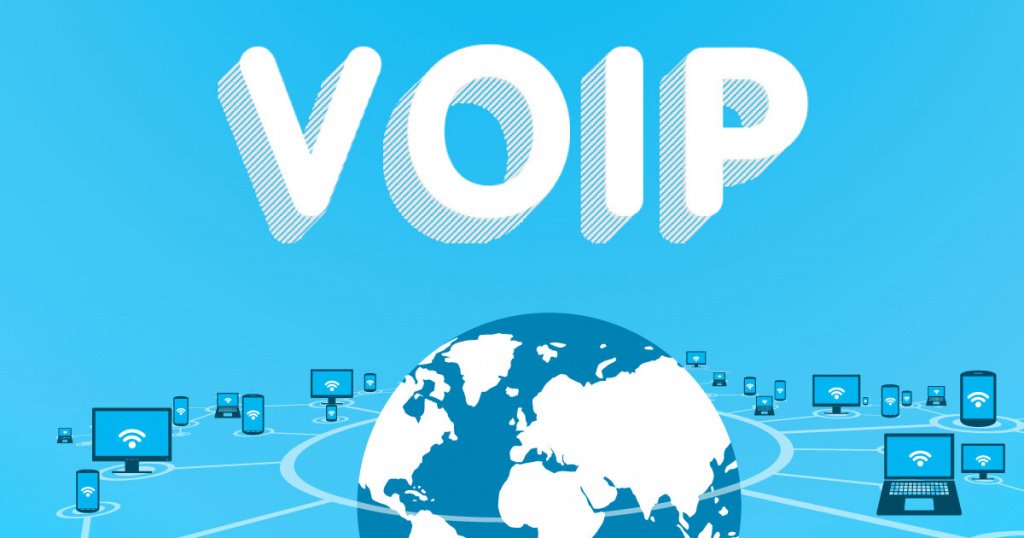In today’s hyper-connected world, effective communication is more critical than ever for businesses. Traditional landline phone systems, while still widely used, are quickly being replaced by a more modern and flexible technology – Voice over Internet Protocol (VoIP).
If you’re unfamiliar with VoIP or wondering how this revolutionary communication solution works, you’ve come to the right place. In this blog post, we’ll dive deep into the world of VoIP, exploring what it is, how it functions, and the benefits it can bring to your organization.
What is VoIP?

VoIP, or Voice over Internet Protocol, is a technology that allows you to make and receive phone calls using an internet connection instead of a traditional landline phone system.
In more detail, VoIP works by converting your voice into digital data packets that are then transmitted over the internet to the recipient’s VoIP device or server. This process involves a few key steps:
- Your voice is converted into digital data packets.
- The data packets are encoded and compressed using specialized codecs.
- The compressed data packets are sent over the internet using Internet Protocol (IP).
- At the receiving end, the data packets are decompressed and converted back into an analog audio signal that the recipient can hear.
The main advantages of VoIP compared to traditional landline phone systems include:
- Cost savings, especially for long-distance and international calls
- Increased flexibility, allowing you to make and receive calls from anywhere with an internet connection
- Enhanced features like call forwarding, voicemail, conference calling, and integration with other business tools
- Scalability to easily add or remove users and features as needed
- Improved reliability with redundancy and failover mechanisms
Overall, VoIP technology has revolutionized business communication by providing a more modern, cost-effective, and feature-rich alternative to traditional phone systems. By understanding how VoIP works, businesses can make an informed decision to modernize their communication capabilities.
How Does VoIP Work?
Here’s a more detailed explanation of how VoIP (Voice over Internet Protocol) works:
- Conversion to Digital Data:
- When you speak into a VoIP phone or softphone (a software-based phone on your computer or mobile device), your voice is converted into digital data packets.
- Encoding and Compression:
- The digital data is then encoded and compressed using specialized codecs (coder-decoders) to reduce the file size and ensure efficient transmission over the internet.
- Codecs like G.711, G.729, and Opus are commonly used in VoIP systems to encode the voice data.
- Internet Transmission:
- The compressed data packets are sent over the internet to the recipient’s VoIP device or server using the Internet Protocol (IP).
- VoIP protocols like Session Initiation Protocol (SIP) and Real-Time Transport Protocol (RTP) are used to manage the call setup, tear-down, and real-time transport of the voice data.
- Decompression and Conversion:
- At the receiving end, the data packets are decompressed and converted back into an analog audio signal that the recipient can hear.
- The receiving VoIP device or softphone uses the appropriate codec to decompress and convert the digital data back into audio.
- Real-Time Communication:
- VoIP technology employs various protocols, such as SIP and RTP, to ensure that the voice data is transmitted and received in real-time, enabling seamless and natural-sounding conversations.
- These protocols help synchronize the audio data and minimize latency, ensuring that the conversation feels natural and immediate.
To use VoIP, you’ll need the following essential components:
- VoIP Phone or Softphone: This is the device you’ll use to make and receive calls, either a dedicated VoIP phone or a software-based application on your computer or mobile device.
- VoIP Service Provider: A company that offers VoIP services, providing the necessary infrastructure and features to facilitate your voice communications.
- Reliable Internet Connection: VoIP requires a stable and high-speed internet connection to ensure clear audio quality and uninterrupted call flow.
The key advantage of VoIP is that it allows you to make and receive calls over the internet, rather than relying on traditional landline infrastructure. This provides cost savings, increased flexibility, and advanced features compared to traditional phone systems.
Benefits of VoIP
Here are some of the key benefits of using VoIP (Voice over Internet Protocol) technology:
- Cost Savings:
- VoIP calls, especially long-distance and international calls, are typically much cheaper than traditional landline phone calls.
- VoIP systems often have lower monthly service fees and eliminate the need for expensive hardware and maintenance associated with traditional phone systems.
- Increased Flexibility:
- VoIP allows you to make and receive calls from anywhere with an internet connection, enabling remote work and mobility.
- Users can easily add, remove, or modify features and services as needed, without the constraints of traditional phone systems.
- Enhanced Features:
- VoIP systems often come with a wide range of advanced features, such as call forwarding, voicemail, conference calling, call recording, and integration with other business tools.
- These features can improve productivity, collaboration, and customer service.
- Scalability:
- VoIP systems are easily scalable, allowing you to add or remove users and features as your business grows or changes.
- This makes VoIP a suitable solution for businesses of all sizes, from small startups to large enterprises.
- Improved Reliability:
- VoIP systems often incorporate redundancy and failover mechanisms, reducing the risk of downtime and ensuring more reliable communication.
- In the event of a power outage or internet disruption, many VoIP providers offer alternative options, such as call forwarding to mobile devices.
- Easier Management:
- VoIP systems are generally easier to manage and maintain compared to traditional phone systems, as much of the infrastructure and maintenance is handled by the VoIP service provider.
- This can free up IT resources and reduce the need for in-house telephony expertise.
- Unified Communications:
- VoIP can be integrated with other communication and collaboration tools, such as video conferencing, instant messaging, and file sharing, creating a unified communications platform.
- This can improve overall productivity and streamline business operations.
The combination of cost savings, increased flexibility, enhanced features, and improved reliability make VoIP an attractive option for businesses of all sizes, enabling them to modernize their communication capabilities and enhance their overall efficiency.
Which is the Best VoIP Phone Service?
There is no single “best” VoIP phone service, as the “best” option can vary depending on the specific needs and requirements of a business or individual. However, here are some of the top and highly-rated VoIP phone service providers to consider:
- Zoom Phone:
- Part of the popular Zoom video conferencing platform
- Offers a robust set of features including call forwarding, voicemail, and integration with other Zoom tools
- Scalable and reliable, with global coverage
- Competitive pricing, especially for businesses already using Zoom
- RingCentral:
- Comprehensive VoIP and unified communications solution
- Offers a wide range of features like auto-attendant, call queues, and team messaging
- Highly scalable and customizable to fit the needs of businesses of all sizes
- Known for its reliable service and 24/7 customer support
- Vonage Business Communications:
- Established VoIP provider with a strong track record
- Offers a variety of plans and features, including call forwarding, virtual faxing, and mobile apps
- Integrates with popular business tools like Salesforce and Microsoft 365
- Known for its reliable service and comprehensive features
- 8×8 X Series:
- Robust VoIP and unified communications platform
- Offers advanced features like call analytics, call recording, and video conferencing
- Scalable for businesses of all sizes, with global coverage
- Emphasis on reliability and security
- Nextiva:
- Comprehensive VoIP and business communications solution
- Offers a wide range of features, including automated attendant, call monitoring, and team collaboration tools
- Highly rated for its user-friendly interface and customer support
- Competitively priced, especially for small to medium-sized businesses
When choosing a VoIP phone service, consider factors such as the size of your business, your feature requirements, integration needs, reliability, customer support, and overall cost. It’s also a good idea to try out a few options and compare their offerings before making a decision.
How to Make a Call Using VoIP
Here are the typical steps to make a call using a VoIP (Voice over Internet Protocol) system:
- Set up your VoIP equipment:
- If using a VoIP phone, connect it to your internet router or modem.
- If using a VoIP softphone (software-based phone) on your computer or mobile device, install the necessary VoIP application and ensure it is properly configured.
- Log in to your VoIP service:
- If using a VoIP phone, you may need to enter your login credentials (username and password) to access the VoIP service.
- For a VoIP softphone, you’ll typically log in to the application using your account information.
- Dial the number:
- On a VoIP phone, use the keypad to enter the phone number you want to call.
- In a VoIP softphone, look for the dial pad or search function to enter the number.
- Connect the call:
- Once you’ve entered the number, press the “Call” or “Dial” button to initiate the VoIP call.
- Communicate:
- Your VoIP device will establish a connection with the recipient’s VoIP system or traditional phone number.
- You can then have a conversation just like a regular phone call.
- End the call:
- To end the call, press the “Hang Up” or “End Call” button on your VoIP phone or softphone.
Additional tips:
- If you’re calling a traditional landline or mobile number, you may need to include the full country code and area code.
- Many VoIP services offer advanced features like call forwarding, voicemail, and conference calling, which you can access through the VoIP phone or softphone interface.
- Ensure you have a stable and reliable internet connection for the best call quality.
- Some VoIP services may require you to configure settings or install additional software on your device.
The specific steps may vary slightly depending on the VoIP provider and the type of VoIP device you’re using, but the general process remains similar across different VoIP systems.
Conclusion
In the rapidly evolving landscape of business communication, VoIP has emerged as a game-changer, offering a cost-effective, flexible, and feature-rich alternative to traditional landline phone systems. By understanding how VoIP works and the benefits it can provide, you can make an informed decision to modernize and streamline your organization’s communication capabilities, giving you a competitive edge in today’s dynamic market.

Hello everyone! We’re Galussothemes content team, we love to write new blogs for WordPress Joomla! and other tech niches everyday. We’re talented young people who hold a strong passion for website development, designing, and marketing. Feel free to leave your comment if you have any issues or questions with our blogs.












